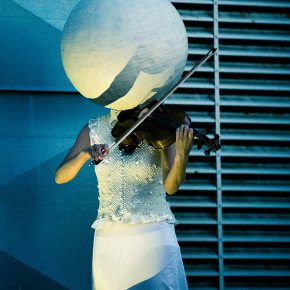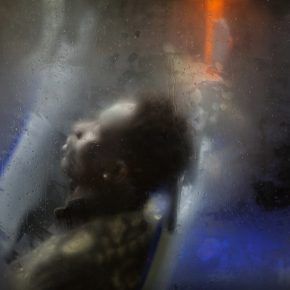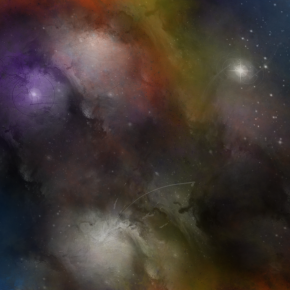Monthly Archives: January 2018
Christopher Bernard reviews Mugwumpin’s new production, In Event of Moon Disaster (at Z Below, San Francisco)
Isa Musni in Mugwumpin’s “Moon Disaster.” Photo by Battista Remati.
SWEET LUNACY
In Event of Moon Disaster
Mugwumpin
At Z Below
San Francisco
Through January 28, 2018
A review by Christopher Bernard
The latest thought-provoking work by Mugwumpin, the award-winning theatrical group based in San Francisco, is inspired by one of the most dramatic what-if moments of the 1960s—a decade in no need of more drama than it was already cursed with. What if humanity’s first journey to a world beyond earth had ended tragically? What if Apollo XI’s Neil Armstrong and Buzz Aldrin had never made it home from the surface of the moon in that fateful summer of 1969?
Anyone alive at the time, who was both conscious and near a radio or TV, knew that such a disaster was an entirely realistic possibility. It took little imagination to conceive of a plethora of accidents, miscalculations, technical glitches, system bugs, slip-ups, oversights, results of ignorance, and even acts of sabotage, that would have made the moon landing a disaster of historic proportions, and one that would have been seen by much of mankind at exactly the same time.
(Ahem. I realize there are still some who believe that the moon landing was a hoax; if you are reading this, you may leave now. Otherwise, you may find the following prose causes fits, seizures, repressed memories, and a gagging sensation that makes you stop breathing altogether.)
It wasn’t generally known, until revealed some thirty years afterward, that a speech had been written (by William Safire, later a well-known conservative columnist, public intellectual and talking head) for the president to give in case, for whatever reason, the first moon landing ended in catastrophe. The speech (the original of which is in the National Archives) has been published; indeed, a facsimile copy of the typescript, including chilling ancillary material, is included with the performance’s program.
And based on ideas generated by this gruesome “perhaps,” Mugwumpin has created one of its ever-intriguing “devised theater” pieces, based on two years of research and group work, script writing, improvisation, exploration in words, dance, music, costume, and video projection. The often fascinating, if not entirely satisfactory, results are on display at Z Below (at Project Artaud) in San Francisco. It is something that anyone curious about the vanguard of contemporary theater owes it to themselves to see.
As usual with Mugwumpin, the audience (limited to 35 members per performance) is required to perform some participatory antics, though nothing as elaborate as in some of Mugwumpin’s most spectacularly successful pieces (such as that wondrous theatrical machine and fantasy generator, performed in the ghostly labyrinth of San Francisco’s Old Mint, “Future Motive Power,” which first introduced to me to this company’s learned, deeply thoughtful, audaciously inventive, and lucidly ludic imagination).
Upon receiving your ticket, you are handed a small plastic ball, a little moon of your own, to pocket like your own satellite, which you are welcome to drop in a bucket, leave by your seat, flick at a performer if you’re feeling especially ludic, or take home with you afterwards (as I did; it is now being played with, as any moon should be, by our youngest cat).
The performance begins in the lobby, where the performers, most of whom appear in (to use my companion’s term) space drag, based on a kind of “retro-futurism”—a return to the starry-eyed optimism of the space program of that rapidly vanishing era— launch our journey to the far-side of a never-to-be-completely-known moon through video and computer projections of a fantasy astronaut crew, half male, half female (which is only fair, though to this day there are far fewer female than male astronauts), caught in a sci-fi spacetime warp where disaster’s shadow looms. We are all astronauts now: the lobby is our decompressive airlock before we are allowed out-in to the inner-outer space of the liminal universe of their/our imagination.
And in, out, around, and away we go.
(One of the show’s most interesting aspects needs to be mentioned here: it’s play throughout on such words and concepts, as used in the world-outside-the-world that is the universe outside earth, as “up,” “down,” “in,” “out,” “around,” “on,” “free,” “lost” (as in “Am I free? Or am I lost? Is there a difference?”) There is even an informative lecture on how space professionals refer to visiting another planet: for example, one goes “in” to the moon when landing upon it, “out” from it when leaving it, “around” it when orbiting it. “Up,” “down,” “above,” “below,” even “right” and “left,” are, one imagines, too relative to the speaker’s physical position in the weightlessness of space to have much meaning. At some point, no doubt, we will have to create an arbitrary but universally agreed on standard of coordinates for the universe as a whole, just as we have for earth, so we can decide, and understand, where we are.)
Once inside the small “black box” theater at Z Below, we were lined up on a narrow stage-like margin, a bit as in a very long police lineup, and watched, in the staging area below, a dance of the astronauts, in orbits within orbits, depicting the moon orbiting the earth, and the earth orbiting the sun, to quiet music performed by Erin Mei-Ling Stuart, who provides much of the show’s music and also plays the embodiment of the myth and magic, the witch, of the moon.
Soon after, a mob of small stools was dragged into the central area and we were invited to settle ourselves on them, helter-skelter, and the rest of the performance was performed, for the most part, on the narrow surround stage and projected against the walls around us.
The show intertwines several story lines. One is of two astronauts on the moon, who babble to each other in the hapless doublespeak of technological abstraction so advanced as to seem to have no meaning at all (the astronauts sometimes sound like robots trying to sound like human beings, which may be a theatrical mistake, as it deprives them of some of the humanity we as an audience need to be feel to fully identify with them). The two astronauts lose communication with earth and, as they face the likelihood of catastrophe, provide the show’s central drama. This story line is enriched by the most imaginative uses of theatrical space in the show, in particular, in the latter half, a spectral use of scrim and distantly lit heads of the astronauts in their peculiarly vulnerable-looking helmets against a wall of absolute darkness.
Another story is about Mimi, a young Latina who loves science and wants to become an astronaut, but also has a social conscience, and must decide which to follow: her deepest heart’s desire to explore space, or another desire, hardly less deep, to improve the lives of her people; of all people, suffering, fraught and foolish humanity, on earth.
Yet another story is of the Moon herself and her appearances throughout human history as a source of myth, magic, and romance; a nightly visible goddess who is made known at first only as song, dance, and story, finally to appear as a voiceless dancer with an immense balloon-like head, a figure of both gentle humor and deep mystery.
What results is a fascinating theatrical fantasy that only occasionally gets snagged in new-agey shallows and preachiness (though it has the good sense to poke fun at its inevitable californitis). Though it pays some respect to the tragic implications of astronauts losing their lives on their missions, it does not explore those implications deeply enough to be altogether convincing, and so the attempts at optimism in the piece ring a bit hollow and vaguely nihilistic (another symptom of californitis: “Well, yes, everybody dies in the end, boohoo, but chin up: we can have a great time while waiting!”) There is a smiley-face whimsy playing with the tragic fate of mankind that sometimes feels forced. The show also sometimes seems to work at cross-purposes with itself, as if its creators could not in the end decide exactly what they wanted the show to be, and tried to do too many things at the same time, some of them mutually undermining. (A prime example: the tragic end of the two astronauts is not adequately combined with the show’s fundamental optimism and its insistence on a happy ending, and so the ending feels unconvincing.)
The show is also a bit too long: it has effectively ended as the female astronaut, fading away in an over-sized video projection while either making her last transmission to earth or talking to herself to give herself courage after her communication link has died, takes courage to “step . . . on . . . step . . . on . . . step . . . on.” But the show’s creators, possibly because of over-commitment to the show’s ternary concept, make a false step in continuing for another ten minutes of a contrived cheerfulness that could well be lost.
Having said that, this imaginative and stimulating show’s many virtues provide an experience that is worth far more than the modest cost of admission. But make sure you bring a companion, as you will have much to talk about afterwards. Mugwumpin remains true to its gifts and its mission: of delving, above all, into questions. They are a gift to anyone who goes to theater for the spark of thought as much as for the heart’s fire.
The talented cast included, besides Stuart, Stephanie DeMott, Soren Santos, Nayeli Rodriguez, Don Wood, and Isa Musni (as the Moon). Wolfgang Wachalovsky and Darl Andrew Packard created the video projections. Natalie Greene, the company’s gifted new artistic director, directed.
_____
Christopher Bernard is co-editor of the webzine Caveat Lector. He is also a novelist (Voyage to a Phantom City and “AMOR i KAOS,” which is being run as a serial in Synchronized Chaos) and poet (Chien Lunatique and The Rose Shipwreck).
Christopher Bernard’s Amor I Kaos: Sixth Installment
Christopher Bernard’s “AMOR i KAOS”: Sixth Installment
Love had nothing to do with it, as the song said. It was all about something in her eyes. They never let you in, and yet they didn’t shut you out completely either. Like the prayers that were her hands. No one knew who knew her, because no one really did. Yet everyone was drawn to her. She became for many of us a craving, like a drug. Her beauty was the heroic kind that turned strong men into bumbling adolescents, whimpering children, and just confused everyone else. She resented her own beauty (he could feel it). It kept lying to other people: it said I love you when she felt no love for them and I hate you when she felt no hatred. It crowded her, turned the silence she craved into a long shouting match, the darkness she loved into a display of fireworks that wore her out with their continual, compulsive brilliance.
—I know you love me but leave me alone for a while, a year, a lifetime.
She learned the hard way that beauty comes at a penalty: stares like a constant punishment.
—Everyone loves me, she said once in despair.
—No, he said, everyone wants you. I love you. And so I shall go away. Even though losing your company breaks my heart and makes me moan in the night. You will probably not believe this, but I’m going to say it anyway. You were the one who introduced me to happiness. You taught me the meaning of joy. I thought I had known before. But I hadn’t, not the ghost of it. Happiness comes with loving you and knowing I am loved by you. Joy is being in the same room with you, in your arms, in the air that surrounds you. But I can give up joy. I don’t really need to see you. Seeing you is a joy that almost intimidates me. I never need to see you, if that is what you want. Loving you is all the happiness I need. I can go on living if I have that – that is what I mean. I will have a reason to live. I can give up that joy if I can keep that happiness.
But she had already gratefully closed the door. And, for safe measure, locked it.
—And I thought you said love had nothing to do with it! Liar, she smiled, hidden in the silence and the dark.
Poetry from Joan Beebe
Synchronized Chaos January 2018: Through a Glass, Darkly
Welcome, readers, to the new calendar year. For many of us, in the Northern hemisphere, this is winter, a time of dark, murky beginnings, which fits with this month’s theme, Through a Glass, Darkly.
The Biblical verse refers to our limited knowledge about matters beyond current human comprehension, to being aware when we don’t fully understand something.
Contributions this month address various aspects of life beyond our immediate grasp.
John Chisoba Vincent’s poetry, strident against injustice in his home country, also includes a poetic search for solace, comfort and protection. J.J. Campbell explores with dark, morbid humor the gap between the glorious life to which the speaker aspires and his actual life, where he’s hung over, alone, and stuffed with too many chicken wings. Mahbub creates poems where speakers reach beyond themselves, considering lost or unattainable loves and natural life that will outlast them after death. Luna Acorcha’s speaker looks at someone from the outside with great admiration.
Heroism, as shown by the protagonists in the books Elizabeth Hughes reviews in her monthly Book Periscope, involves courage, perseverance and dedication on behalf of some distant goal. The children in Juna Jinsei’s The Essence of Neverland, a sequel to Peter Pan, chosen for character traits they add to the cause, help to patch up the fantasy kingdom after Peter’s death. The inadvertent adventurer in Gary Helzer’s Where Losers Live, Heroes Die, the boxer Jack Dempsey, memorialized in Thomas Brennan’s Million Dollar Man, and the stuffed rabbit Bun Bun, whose stalwart patience gets rewarded when her four-year-old human eventually finds her, all strive to achieve goals.
Lola Noir’s poems are more concrete, as she illustrates the seasons through tactile sensations of clothing and temperature. However, she also touches on experiences beyond the immediate, particularly in her poem ‘Sad Girl,’ where a lonely person from a rough background identifies with different social movements while living her individual life. She’s specifically rendered enough to be an individual character, yet, especially since she’s unnamed and addressed in lower case, universal enough to represent many people.
Nostalgia can also pull us beyond our present surroundings, as we see in Lauren Ainslie’s poem, at once a lament about growing up and a fanciful piece about the impetuous energy of childhood. Kaia Hobson’s pieces also address similar themes, with their more traditional evocations of childhood and the joy found in indulging in favorite activities.
Christopher Bernard also contributes a modern nativity, which we published before Christmas but now link here.
Please enjoy reaching for the light of meaning through this issue. We hope that the submissions bring warmth to cheer your winter months.
Poetry from Luna Acorcha
You Know What She’s About
The curve of the mouth
comes loose with her
and she talks like she’s from Texas.
That little painting looks
all cute beside her.
It’s from Texas or something.
You know, I’m not real sure where
I’m coming from
when I say this,
But she makes me think of the south.
And that’s all about Amanda
and Jose.
Jose and Amanda are all about the south.
And she talks like she has
a really big crush on
him, but I totally get it,
it’s hard to resist
he got a real good tan from
Texas.
And it’s cool to talk about the south.
Something warm, she knows.
She’s got the perfect lines.
She’s real cool.
But like whatever.
And she doesn’t really need these
people,
she’s cool without them.
She’s cooler than you.
Poetry from Kaia Hobson
i am okay
i was okay with running
till my little dimpled legs give out
and my feet burn
and the rug spins
and ben’s screeches drown out my giggles
i was okay with taking it slow
squeezing my mother’s thumb
till it turns a deep royal blue
only the tightest of grips could allow
i was okay with staying inside
and flipping page after page
till even my neck hurt
because i could never take this slow
i was okay with drowning
almost
but devoted to the thrill
the boundaries
the doors, open
like i was
and i want to stay like this
bundled up warm in these blankets
of why i am
but the warmth is fading
and i want it back



